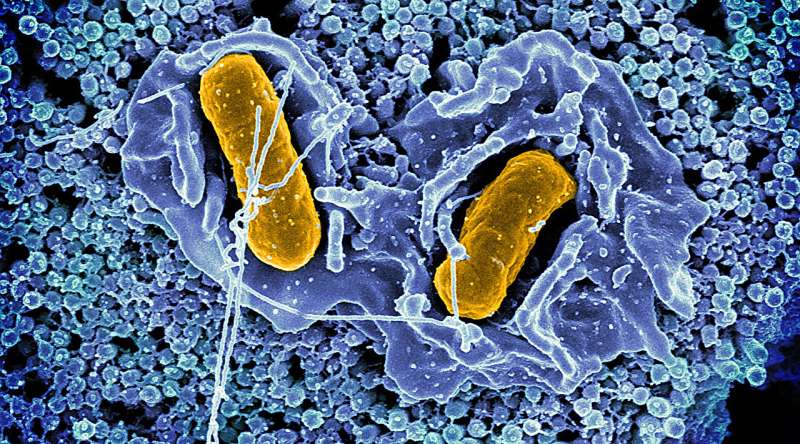This article has been reviewed according to Science X's editorial process and policies. Editors have highlighted the following attributes while ensuring the content's credibility:
fact-checked
trusted source
proofread
Rising antimicrobial resistance in certain Salmonella serovars isolated from retail chicken meat

Salmonella infections are a major public health issue in the United States, causing over 1.3 million illnesses annually. These infections are a leading cause of foodborne illness, often traced back to raw or undercooked poultry meat and eggs. Emerging antimicrobial resistance in Salmonella isolates found in retail chicken meat is a growing concern, the trends of which were recently explored in a new study by a group of researchers from the University of Illinois Urbana-Champaign.
The study is published in the journal Food Control.
Salmonella comprises thousands of strains, known as serovars, which vary in their prevalence, distribution, and antimicrobial resistance across different regions. Controlling Salmonella outbreaks can be challenging, as the pathogen is very diverse and some serovars are multi-drug resistant. Furthermore, infections in poultry often aren't easy to detect.
"The problem in detection is that some Salmonella serovars don't infect poultry, and in many cases, the chickens do not present as clinically ill," said Csaba Varga (IGOH), an assistant professor of epidemiology specializing in the distribution and spread of diseases. "They can appear healthy while still harboring Salmonella, and then humans consume the meat and get infected."
To monitor Salmonella's presence and antimicrobial resistance in retail chicken meat, the National Antimicrobial Resistance Monitoring System for Enteric Bacteria has been sampling chickens since 2002. Longitudinal datasets like these are invaluable for tracking changes in the bacteria over time, said Varga. In his recent study, he and his team utilized this extensive dataset to explore trends in the prevalence of the most common serovars of Salmonella and their antimicrobial resistance patterns over recent years.
The team includes Nasim Sohail, a visiting research scholar at the College of Veterinary Medicine, and Hamid Sodagari, a postdoctoral researcher in Varga's lab, and first author on the study.
They examined publicly available data on nearly 40,000 samples taken from retail chicken meat between 2013 and 2020. Of these, approximately 3,000 samples (7.7%) tested positive for Salmonella. The four most common serovars identified were S. Kentucky, S. Typhimurium, S. Infantis, and S. Enteritidis. Notably, S. Kentucky was the most prevalent serovar in poultry, constituting about 35% of Salmonella-positive samples. However, Varga points out that it is of less concern because S. Kentucky rarely infects humans, unlike the other three serovars.
While the average prevalence of S. Kentucky and S. Enteritis has remained relatively stable over the years, the researchers observed a significant decline in S. Typhimurium and a dramatic increase in S. Infantis from 2013 to 2020.
"We were expecting to see a decrease in Typhimurium due to the live attenuated Typhimurium vaccine that the poultry industry has been using," explained Varga. "But controlling for one serovar can open up the niche, allowing others to take over. We expected to see a potential increase in other serovars due to this. However, we didn't expect such a dramatic increase from S. Infantis."
Varga went on to explain that the prevalence of S. Infantis surged from around 3% of positive Salmonella samples in 2015 to nearly 40% in 2020. This is particularly concerning due to the high levels of antimicrobial resistance found among S. Infantis samples.
"S. Infantis has become increasingly prevalent and has recently emerged as multidrug-resistant due to a plasmid (pESI) within that serovar," said Sohail. "This plasmid contains several antimicrobial resistance and virulence genes, that help with the pathogenesis of S. Infantis. This is likely why it is increasing in prevalence not only in the United States but also across the globe."
The other serovars also demonstrated varying levels of antimicrobial resistance. Additionally, the four serovars varied in their spatial distribution across the United States, with high-proportion clusters of S. Typhimurium more commonly detected along the East Coast, and S. Kentucky along the West Coast and southern states.
Several factors could influence the distribution of Salmonella serovars, such as environmental differences or variations in chicken management practices. However, the researchers say more studies are needed to explore these factors in detail.
The emergence of a multidrug-resistant S. Infantis serovar in the United States and worldwide is a significant public health concern. These findings underscore the need for further research and the implementation of serovar-specific mitigation strategies in the poultry production chain, said Varga.
"Our results show that the vaccination against S. Typhimurium is working, but that the industry will have a new challenge to control S. Infantis," explained Varga. "They will likely need to figure out a different type of intervention since the current mitigation efforts are not working against it. This just shows we need to consider serovar-specific control measures for Salmonella in the future."
The team plans to further investigate how management practices affect the development of antimicrobial resistance, and explore what can be done to reduce Salmonella prevalence and resistance to antimicrobials. Varga stresses that even with efforts to reduce Salmonella, it is unlikely to disappear anytime soon. Therefore, consumers should take safety precautions when handling and consuming poultry.
"We can work to reduce Salmonella, but it won't disappear," said Varga. "Consumers need to be aware that they must take food safety precautions to cook poultry meat to temperature and not cross-contaminate food products in the kitchen."
More information: Hamid Reza Sodagari et al, Differences in the prevalence and antimicrobial resistance among non-typhoidal Salmonella serovars isolated from retail chicken meat across the United States of America, 2013–2020, Food Control (2024). DOI: 10.1016/j.foodcont.2024.110701
















